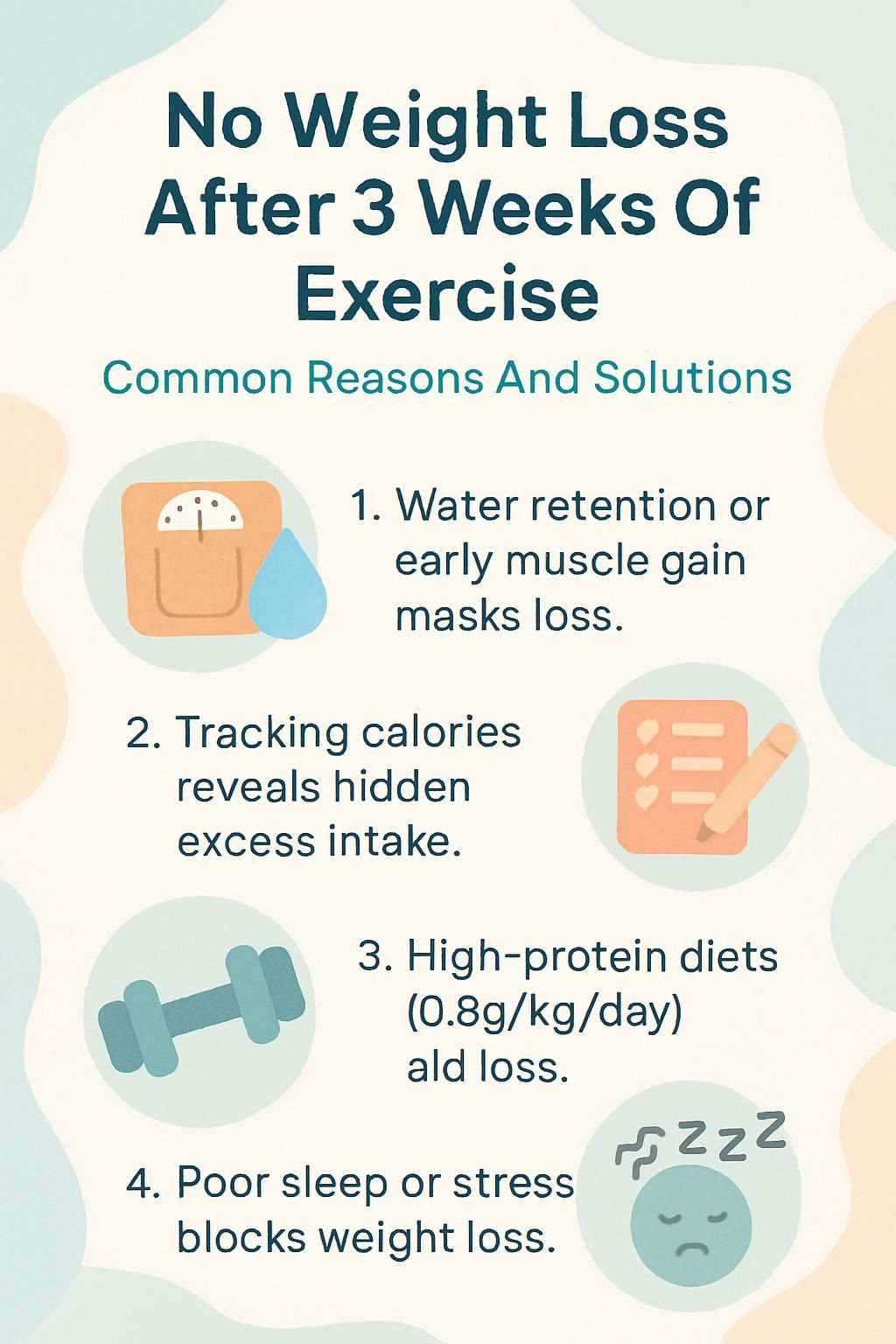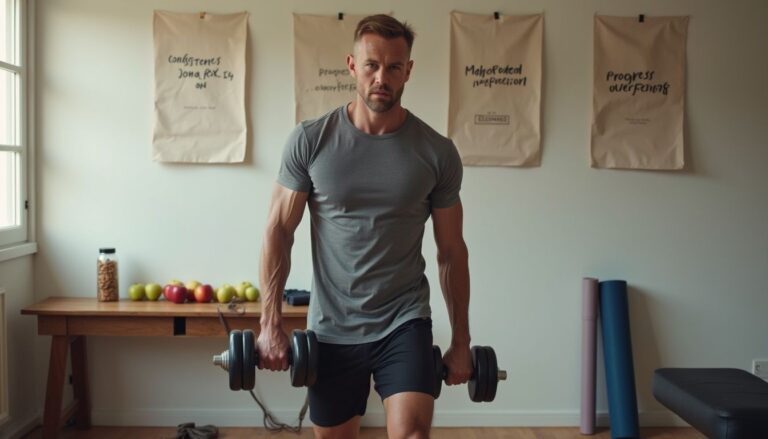No Weight Loss After 3 Weeks Of Exercise: Common Reasons And Solutions
Our Nutrition Assistant AI Suite will transform your body. You will lose fat, get toned, and build muscle. Gain confidence and optimal health.
Seeing no weight loss after three weeks of exercise can feel discouraging. You might be eating well and working out regularly, yet the scale refuses to move. Early plateaus are common in weight loss, especially after an initial drop in water weight and a shift in metabolism.
This guide explains the most common reasons you may not be losing weight and offers simple fixes. You will learn how to adjust your calorie intake, choose smarter workouts, and improve sleep and stress. These small changes help rebuild a calorie deficit and support healthy weight loss.
Key Takeaways
- Water retention and early muscle gain can hide fat loss on the scale for weeks.
- Tracking intake with a food diary or app exposes hidden calories from sauces, snacks, and drinks.
- Protein supports fullness and muscle. Aim for at least 0.8 g per kg body weight daily, and consider 1.2 to 1.6 g per kg when trying to lose fat.
- Strength training and high-intensity intervals raise calorie burn and help preserve lean muscle during a deficit.
- Short sleep, chronic stress, certain medications, and conditions like hypothyroidism can slow progress. Talk with your clinician if results stall.

Understanding Early Weight Loss Challenges

Early progress can look messy. The number on the scale often lags behind real changes in your body.
How Does Water Retention Affect Weight Loss?
Your body stores carbohydrate as glycogen. Each gram of glycogen holds about 3 to 4 grams of water. During the first week of changing your diet or starting exercise, you burn through glycogen and lose water fast.
After that, water shifts day to day. Sodium intake, sore muscles, stress, and menstrual cycles can all increase water retention. This can hide fat loss and make the scale bounce.
What helps right now:
- Weigh less often, for example twice per week, then average the numbers.
- Track waist measurements and take photos every two to four weeks.
- Aim for steady hydration and moderate sodium to reduce big swings.
Even if the scale stalls, looser clothes and less bloating are strong signs of progress.
Can Muscle Gain Mask Fat Loss?
New lifters often gain a little muscle while losing fat. Muscle is denser than fat and takes up less space, so your shape can change without a big drop on the scale.
Better markers than weight alone include waist size, progress photos, and how your clothes fit. Preserving muscle also supports your metabolism, the calories you burn at rest.
A gym client shared this simple win: after adding two days of lifting, pants fit looser though weight barely moved for two weeks. That is normal and often a positive sign.
What Causes No Weight Loss After 3 Weeks?
Three weeks can feel long when you are trying to lose weight. Several common habits can erase a calorie deficit and slow results.
Am I Eating Too Many Calories?
Many people underestimate portions. Liquid calories, cooking oils, nut butters, and snack bites add up quickly. Writing down what you eat increases awareness and can help you lose more weight.
- Log meals and drinks for at least 7 days, including weekends.
- Measure portions for calorie-dense foods like nuts, cheese, and dressings.
- Keep most beverages calorie free, such as water, tea, or black coffee.
Avoid dropping below 1,200 calories per day unless a clinician guides you. Very low intake can spike hunger later and lead to overeating.
Can Restrictive Diets Hinder Weight Loss?
Severe calorie restriction often backfires. Your body may reduce daily energy use, and you feel more fatigued. Nutrient gaps can also appear when food choices are too narrow.
Balanced meals paired with regular activity work best. Include foods you enjoy in reasonable portions so the plan is sustainable. Feeling satisfied makes it easier to stay consistent.
Is My Protein Intake Enough for Weight Loss?
Protein increases fullness and protects lean muscle during a deficit. It also helps steady appetite hormones. Ghrelin increases hunger, while peptide YY and others help you feel satisfied.
- Baseline target: at least 0.8 g protein per kg body weight daily.
- Helpful for fat loss and lifting: 1.2 to 1.6 g per kg body weight daily.
- Spread protein across meals, for example 20 to 40 grams per meal.
People who eat higher protein often lose more fat and keep more muscle. That supports a stronger metabolism and better long term weight management.
How Does Drinking Too Little Water Affect Weight?
Poor hydration can increase water retention and trigger hunger signals. Many confuse thirst with hunger and eat more as a result.
- Replace sugary drinks with water to reduce daily calories. Studies show average weight loss near 5 percent when people consistently swap in water.
- Drink a glass of water before meals to help with portion control.
- Bring a bottle to workouts to reduce fatigue and maintain effort.
Small hydration habits make fat loss easier and keep workouts productive.
Are Processed Foods Preventing Weight Loss?
Highly processed foods are easy to overeat. They often contain added sugar, refined flour, and fats that push calories up while fullness stays low.
- Base most meals on whole foods, such as vegetables, fruit, lean protein, beans, and whole grains.
- Set a simple rule: limit packaged snacks to once per day or less.
If cravings feel hard to control, consider brief support from a dietitian or weight loss coach. A short plan can reduce trigger foods while keeping meals satisfying.
What Impact Do Hidden Sugars and Alcohol Have?
Sweet drinks like soda, flavored teas, sports beverages, and fruit juice pack fast calories. A single bottle can equal several pieces of fruit in sugar.
Alcohol adds about 7 calories per gram. Beer, wine, and mixed drinks can push intake over your daily target. Drinking may also increase appetite and promote fat storage in adipose tissue.
- Cap alcoholic drinks, for example one to two per week, or pause for a month.
- Choose zero sugar mixers, or swap to sparkling water with lime.
Cutting liquid calories is one of the quickest ways to regain a calorie deficit.
How Exercise Habits Affect Weight Loss Progress
Smart training helps you burn more calories and protect muscle. Think of your plan as a mix of cardio, strength work, and daily movement.
Is My Workout Intensity or Variety Enough?
Your body adapts fast to the same routine. To keep losing weight, include both moderate and vigorous efforts across the week.
- Try high-intensity interval training one or two days weekly.
- Add resistance work two or three days weekly.
- Vary cardio: cycle, jog, row, swim, or climb stairs.
When workouts begin to feel easy, increase one variable at a time: a few more minutes, a bit more speed, or slightly heavier weight.
Why Is Strength Training Important Alongside Cardio?
Strength training helps you build and maintain muscle mass. Muscle burns more calories than fat, even while you rest. That supports weight loss and weight maintenance.
Combining a higher protein intake with lifting protects lean tissue while you eat fewer calories. It also targets deep belly fat linked to type 2 diabetes and heart disease risk.
How Does Poor Recovery Affect Weight Loss?
Hard training without recovery can raise cortisol, a stress hormone that encourages fat storage. Sleep loss makes hunger stronger and workouts feel harder.
- Plan at least one to two rest days per week.
- Aim for 7 to 8 hours of quality sleep nightly.
- Use active recovery like walking, stretching, or gentle yoga.
These habits keep training effective and reduce cravings for high calorie snacks.
Can Sitting Too Much Negate Exercise Benefits?
Long sitting time can erase some benefits of your workouts. Non-exercise activity thermogenesis, called NEAT, is the energy you burn through daily movement.
- Stand or walk for 3 to 5 minutes each hour.
- Take phone calls while standing. Park farther away and use the stairs.
- Aim for 6,000 to 8,000 steps per day, then build from there.
These small changes can burn hundreds of extra calories each week.
What Is Progressive Overload and Why Does It Matter?
Progressive overload means steadily increasing workout challenge over time. You can add weight, reps, sets, speed, or reduce rest.
- Add 2 to 5 pounds to lifts as form allows.
- Do 1 to 2 more reps per set, or one extra set.
- Trim rest by 10 to 15 seconds between sets.
Consistent overload signals your body to adapt, build strength, and keep burning more calories.
How Lifestyle Factors Influence Weight Loss
Daily habits outside the gym often decide whether losing weight feels manageable or hard.
How Does Stress and Cortisol Affect Weight?
Stress can raise cortisol and drive cravings for sugar and fat. Higher cortisol is linked to more abdominal fat and higher hunger.
- Practice brief stress resets, such as box breathing for 2 minutes.
- Plan stress snacks in advance, for example fruit and Greek yogurt.
- Schedule short breaks during the day to reduce tension.
Simple coping tools help protect your calorie deficit and curb late night eating.
Why Is Sleep Quality Important for Losing Weight?
Short sleep changes appetite hormones and raises cravings. Adults should get 7 to 8 hours each night. Teens need 8 to 10 hours.
- Set a wind down alarm 45 minutes before bed.
- Dim lights, limit caffeine after noon, and keep the room cool and dark.
- Keep phones and tablets out of arm’s reach to reduce scrolling.
Better sleep supports the discipline you need for diet and exercise choices.
Does Being Sedentary Affect My Weight Loss?
Yes. Even with workouts, long periods of sitting reduce daily calorie burn. Build movement into regular tasks to lift NEAT.
- Walk while listening to podcasts or during study breaks.
- Do brief chores between meetings to keep moving.
These habits make your calorie deficit more reliable day to day.
What Medical and Physiological Issues Can Block Weight Loss?
Sometimes biology gets in the way. If progress stalls despite strong habits, consider medical factors.
Could Undiagnosed Conditions Be Affecting My Weight?
Low thyroid function, polycystic ovary syndrome, and sleep apnea can slow metabolism or raise appetite. These conditions can make it hard to lose weight even with diet and exercise.
If you have ongoing fatigue, hair loss, low mood, heavy snoring, or irregular cycles, ask your clinician about testing. Treating a root cause can restart progress.
Can Medications Cause Weight Retention?
Some drugs can increase appetite or fluid retention. Examples include certain antidepressants, insulin or sulfonylureas for diabetes, beta blockers for blood pressure, some birth control pills, and steroids used for inflammation.
Never stop a prescription on your own. Ask your healthcare provider if a weight neutral option exists for your situation.
How Do Hormonal Imbalances Impact Weight Loss?
Hormone shifts can slow calorie burn and increase fat storage. Thyroid, insulin, and sex hormones each play a role in hunger and energy use.
Regular health screenings and targeted treatment can improve appetite control and metabolic rate. That makes diet changes more effective.
Does Age or Diet History Slow Metabolism?
As you age, muscle mass tends to decrease. Less muscle lowers resting metabolic rate, the calories you burn at rest.
Repeated crash dieting can lead to metabolic adaptation. Your body learns to run on fewer calories, which makes the next attempt harder. Strength training and a higher protein intake help counter these effects.
How to Break Through Weight Loss Plateaus
Plateaus are normal. The goal is to make small, steady adjustments that rebuild a calorie deficit and keep muscle.
How Do I Monitor and Adjust Caloric Intake?
Track meals and drinks for one to two weeks. Look for hidden calories from oils, dressings, snacks, sugary coffees, and alcohol.
- Reduce portions by about 10 percent to test a new target.
- Fill half your plate with vegetables, then add lean protein and whole grains.
- Eat without screens so fullness cues are easier to notice.
If hunger spikes, increase protein or high fiber foods rather than cutting calories lower.
Why Add Strength and High-Intensity Training?
Strength work preserves muscle while you lose fat. High-intensity intervals increase calorie burn during and after the workout.
- Lift 2 to 4 days per week using major movement patterns: squat, hinge, push, pull, and carry.
- Do 6 to 10 short intervals, for example 30 seconds hard and 90 seconds easy.
These upgrades support your metabolism and help break plateaus even when the scale is slow to change.
How Can a Balanced Diet Help Weight Loss?
Balanced meals help you stay full on fewer calories. Build plates from whole foods most of the time, then include small portions of favorite treats.
- Protein anchor first, vegetables second, then add smart carbs and healthy fats.
- Limit ultra-processed items to reduce cravings and energy swings.
This approach is easier to maintain, which matters most for long term results.
How Does Hydration and Reducing Alcohol/Sugar Help?
Water supports appetite control and performance during exercise. Swapping sugary drinks for water reduces intake with little effort.
- Drink a glass of water before each meal.
- Trade soda and juice for water, seltzer, or unsweetened tea.
- Keep alcohol for special occasions or skip it for a month.
Many people notice fewer cravings and better sleep once liquid calories drop.
Why Prioritize Sleep and Stress Management?
Adults need 7 to 8 hours of sleep to keep hunger hormones steady. Chronic stress raises cortisol and can drive overeating.
- Create a 30 minute bedtime routine and stick to it most nights.
- Use brief stress tools during the day, such as breathing drills or short walks.
Better sleep and lower stress make every part of your plan easier to follow.
What Are Realistic Weight Loss Expectations?
Healthy weight loss looks steady, not dramatic. Focus on habits that you can repeat, not on a single number.
When Should I Expect to See Visible Changes?
Many people notice changes in energy and sleep within one to two weeks. Clothing fit and waist size often shift by weeks three to four. The scale may move slower if you are gaining muscle and losing fat at the same time.
Measure progress monthly with a tape measure, photos, and strength gains. Those markers reflect real body changes even if weight lags.
How Can I Celebrate Non-Scale Victories?
Track wins that support your long term goal:
- Stronger lifts, faster walks or runs, or more reps with good form.
- Better sleep, steadier mood, and higher energy.
- Improved blood pressure, glucose, or cholesterol from checkups.
- Consistent habits like choosing water or packing lunch most days.
These victories build confidence and make plateaus easier to handle.
When Should I Seek Help From Weight Loss Professionals?
If results stall after several weeks of steady effort, expert support can speed up problem solving and protect your health.
How Can a Dietitian or Nutritionist Help Me?
A dietitian can assess your intake, uncover hidden calories, and design meals that keep you full while in a calorie deficit. Portion coaching and meal planning make the process easier to follow.
People with diabetes, thyroid issues, or food allergies benefit from medical nutrition guidance. A few check-ins can keep you on track when life gets busy.
Why Customize Workouts with a Personal Trainer?
A trainer matches workouts to your level and goals, then progresses them over time. You learn proper form, which reduces injury risk and makes strength training more effective.
Clear milestones and regular feedback keep motivation high, even when the scale is stubborn.
When Should I Consult a Healthcare Provider?
See your clinician if you suspect a medical issue, if medications changed recently, or if weight does not respond to reasonable diet and exercise. Lab tests can check thyroid, iron, glucose, and other markers that affect weight.
Do not adjust prescriptions on your own. A supervised plan protects your health while you pursue weight loss goals.
Conclusion
No weight loss after three weeks of exercise is common. Water shifts, early muscle gain, and calorie creep can all hide progress. Rebuild a calorie deficit with better tracking, more protein, and fewer liquid calories. Use strength training and intervals to protect muscle and boost metabolism. Improve sleep, manage stress, and move more across the day.
Set realistic expectations for losing weight. If plateaus persist or symptoms suggest a medical issue, consult a healthcare professional. This article is for education only and does not replace medical advice.
Selected sources: Centers for Disease Control and Prevention, American College of Sports Medicine, National Institutes of Health, and peer reviewed studies on protein intake, water replacement, and interval training.
FAQs
1. Why is there no weight loss after 3 weeks of exercise?
Several factors can explain why you see no weight loss after three weeks of exercise. Common reasons include increased muscle mass, water retention, or not creating a calorie deficit. Research shows that early changes in body composition may mask fat loss as muscles retain more fluid during new routines (Hall et al., 2012).
2. How does diet affect weight loss when starting an exercise program?
Diet plays a key role when it comes to weight loss. If calorie intake matches or exceeds calories burned through activity, the scale might not change even with regular workouts. Studies confirm that combining dietary adjustments with physical activity leads to greater results than exercise alone (Johns et al., 2014).
3. Can stress and sleep impact progress if there is no weight loss after exercising for three weeks?
Yes, both stress and poor sleep can slow progress when it comes to weight loss goals. High stress increases cortisol levels which may promote fat storage; lack of rest disrupts hormones that control hunger and metabolism (Spiegel et al., 2004). Managing these factors supports better outcomes.
4. What solutions help overcome stalled progress if there is no change in bodyweight after three weeks?
Tracking food intake, adjusting portion sizes, increasing daily movement outside structured workouts, and reviewing workout intensity are effective strategies when it comes to breaking through plateaus. A personal example: After tracking my meals for one week, I noticed hidden calories from snacks were affecting my results.
Summary: No visible change on the scale after three weeks often relates to shifts in muscle mass, water balance, eating habits, or lifestyle factors like sleep and stress management when it comes to weight loss efforts.
References:
– Hall KD et al., Obesity (Silver Spring), 2012
– Johns DJ et al., J Acad Nutr Dietetics, 2014
– Spiegel K et al., Annals of Internal Medicine, 2004







